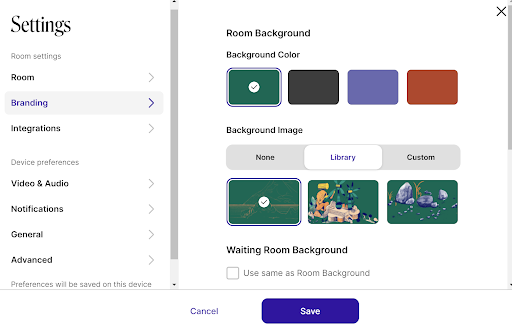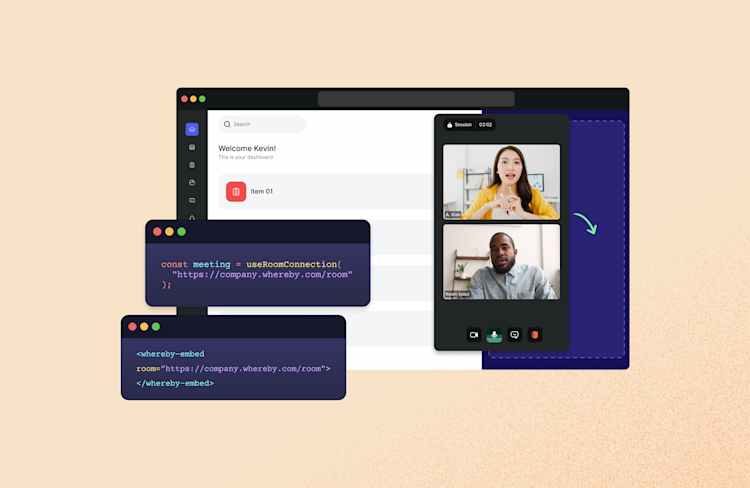Here’s Why the Best Recruiters are Embracing Embedded Video Calling (and Why You Should Too)
More and more recruiters are turning to embedded video calling to help them digitize their hiring processes. Learn how to embed video interviews in your ATS.
Want to provide the best customer experience for recruiters and keep up with competitors? Video interview technology should be embedded directly in your applicant tracking system (ATS) so your customers can make video calls a seamless part of their workflow.
But building live video functionality would take years – not kidding. Fortunately, you don’t have to build a video chat feature from the ground up. In today’s article, we cover the top reasons why you need to offer video interviews in your ATS and how to do this without custom coding.

The rise of the video interview
In a survey of 1,500 talent acquisition professionals from 28 countries and an analysis of data generated by users, LinkedIn discovered that the following trends were the top to emerge out of the challenges of 2020:
More companies will adopt virtual recruiting technology
Talent acquisition will shift towards remote candidates
More companies and recruiters will focus on diversity, equity, and inclusion
70% said that even for on-site jobs, a hiring process that includes virtual and in-person processes will become standard.
For remote, hybrid, and in-person positions, virtual recruiting is here to stay.
Why it’s important for recruiters to embrace video calls
The trends towards digitization, remote work, and hybrid remote work were spurred forward by the pandemic. The importance of video conferencing in the hiring process will likely never go away.
Here are the top three reasons why you should embrace embedded video calling and add this functionality to your applicant tracking platform:
1. Keeping up with the competition
ATS providers that don’t offer video conferencing run the risk of losing out to competitors who incorporate this functionality sooner. With over 513 software products listed as an ATS in G2, there’s certainly plenty of competition. If you don’t offer video interview capabilities, recruiters will start researching video conferencing solutions and applicant tracking systems that include them so they don’t have to pay for another software but can get all the features they need in one place.
2. Customer experience
Providing all of the features that customers need under one roof isn’t just about staving off churn. It’s also about offering a great user experience, and a seamless workflow. 74% of recruiters say that video interviews have made it easier for them to interview and shortlist candidates. This means that an overwhelming majority of your users would probably be thrilled to see video calling capabilities within your recruitment platform.
3. Accessibility
Diversity in hiring requires not only more successful DEI contracts but also increased accessibility and inclusion throughout the hiring process. Video calls make the interview process far more accessible than requiring candidates to come into the office. This allows recruiters to cast a wider net, outside of costly metropolitan areas.
Candidates have come to expect at least one video interview, and when you provide this functionality inside of your ATS, you’ll improve user experience and accessibility for candidates as well. In turn, recruiters will be satisfied knowing they can provide the best possible hiring experience for candidates.
You don’t have to build video conferencing functionality in-house
Many product managers believe that only your core IP should be built in-house. Everything else should be purchased, so long as it represents a cost savings. In the tech world, development teams can purchase all sorts of ready-made solutions, whitelabel them, and add them to their platform. Common examples include CSV importers, secure document signing, and payment processing.
By the same token, you don’t have to build a video conferencing platform in-house. To do so would be enormously expensive and complicated. That’s because very few software engineers are well-versed in WebRTC, the technology that allows for online audio and video calls with the shortest delay times possible. And even developers who do know WebRTC might not be skilled in algorithmically scaling video quality up and down in order to preserve audio quality no matter what.

Many different types of platforms have used Whereby Embedded to add our conferencing solution to their app, such as healthcare, eLearning, and virtual events software.
“What would have taken us 5 years, took 30 days with Whereby’s API,” says Colin Bramm, CEO & Co-founder of Showbie about using Whereby to add video conferencing to his eLearning solution instead of developing it from scratch in-house.
How to add video calling to your ATS
Let’s dive a little deeper into adding a live video call feature to your ATS platform. Here are the steps you need to consider.
1. Choose a video conferencing solution that can be embedded in your platform directly
Why spend years developing a video call solution when you need to be focused on building your core features?
Embedding an existing solution in your ATS is a smart bet because it allows your development team to focus on your main product roadmap.
The video solution you choose should have these features:
No downloads required, fully web-based
Functions inside of your app with no need to log in to a separate account
Uses WebRTC to offer high-quality video and sound without delay
Includes text-based chat with each conference call
Offers an API for fast implementation
GDPR compliant
End-to-end encryption
Individual secure meeting rooms
Customizable branding so the video rooms match your platform
Screen sharing
Waiting rooms
Room timer

2. Follow the developer guide
Our customers report that they can get up and running with Whereby Embedded in a matter of minutes. All you have to do is add a tiny piece of code to your website or product, customize how you want the video conference to look, and launch it.
There’s also absolutely no maintenance required on your end. Our team takes care of the video UI and API maintenance. Plus, because of our deep knowledge of WebRTC, we’re always working on ways to improve the quality of the audio and video and reduce drag time. This means you don’t have to worry about ever having live video call expertise in-house. Plus, because our video conferencing solution doesn’t require app downloads, installations, or log-ins, it’s not only easy for you to add to your applicant tracking platform, but also super simple for recruiters and candidates to use.
Check out our developer guide, which walks you through our REST API. All you need to get started is a subscription to our Embedded product and an API key.
3. Roll it out and announce it to customers
Once you’ve embedded video meetings in your application, the next step is to test it and roll it out to your users. Let your recruiter customers know about the new functionality and what they can expect. The conferencing solution will be fully white-labeled, so you won’t have to share any additional access credentials.
Use a banner on your website, a blog post, and an email update to share the feature launch.
Here are some things to highlight in your communications with customers:
Calls can be video or audio
Candidates can access the calls inside of your applicant tracking system with no downloads or login credentials required
How the calls interact with other features – for example, note-taking or other candidate-tracking-related functions
What resources are available if they have any questions about the new feature
How to prepare candidates for video interviews
When rolling out video interview functionality to all customers, you might also want to create some helpful content to help customers get the most out of video conferencing.
Here are some guidelines and ideas to help inspire your content related to video interviews (and to help you conduct your own video interviews):
Consent: If you are planning on recording the interviews, you’ll need to have candidates consent to this beforehand.
Requirements: Unfortunately, fraud can be an issue when it comes to virtual hiring processes, particularly with technical talent. This is why it’s important to switch to video interviews, as opposed to audio-only. It’s much harder for someone to be getting outside help for an interview when their camera is turned on.
Expectations: You might also provide candidates with a few expectations, such as that they attend the video interview in a quiet room, so they make sure to do the interview free from distractions.
Video interview technology is essential for remote hiring processes, whether the position is in-person, remote, or hybrid. With embedded video conferencing, you don’t have to custom code your own solution.


